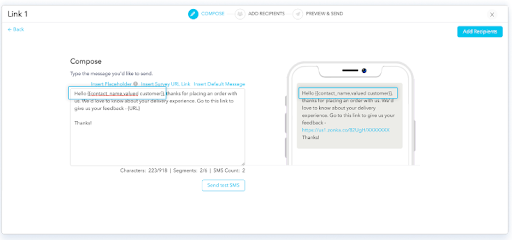Feedback is an essential component of the educational system. It can be incorporated to enhance teaching and learning techniques since it has an immediate impact on the process of acquiring knowledge and has a direct impact on both teaching and learning.
Feedback assists all students in understanding the subject matter and provides clear guidance on how to improve their learning procedure. Feedback can help students gain confidence, self-awareness, and enthusiasm for what they are learning. Giving students relevant feedback can help them improve their academic or fieldwork performance.
Transform Academic Experience with Student Feedback👩🎓
Build student-centric surveys to get real-time feedback and enhance knowledge influx and student engagement with data-driven teaching.

Most education centers have understood the importance of student feedback and therefore are incorporating student feedback software to gather proper insights about the students.
Gone are the days when the education and training enhancement framework was based on traditional student feedback methods. And though traditional feedback may make sense at a smaller level, executing it at scale becomes exhausting for both teachers and students.
Therefore, having a seamless, fun, and interactive feedback system is required to ensure maximum student satisfaction.
What are some factors that increase the importance of student feedback? How can you go about collecting student feedback? We have answered both questions in detail in this article.
Read on.
Importance of Student Feedback
In the points below, we'll look at why feedback is so important in the education sector:
-
Improved Academic Outcomes: Effective and relevant feedback allows learners to reflect on their learning strategies and outcomes, allowing them to make adjustments to make better progress at each stage. But this is only possible when you have a valid feedback strategy designed to determine learners’ levels of understanding, which varies depending on the individual, as well as the rate of skill development. Based on the feedback given by each student, you can divide them into groups and set achievable targets or goals to maximize academic outcomes.
It’s best to keep some tried and tested tips in mind to be able to collect student feedback effectively. I would recommend this blog by Zonka Feedback - 10 Tips to Collect Student Feedback Effectively - if you’re just getting started.
-
Improved Relations and Collaboration: Students understand that their professors are willing to help them and are genuinely concerned about their education when they receive appropriate feedback. This improves relationships among students and teachers and also creates more opportunities for collaboration. Moreover, knowing exactly where the efforts are required ( for example, the need for extra classes, an AI Math Solver, or detailed study material) the process becomes optimized, both in terms of time and efficiency, which further increases the importance of student feedback.
- Improved Process and Faculty Performance: Because we are teaching and learning through a blank screen, feedback in education is critical, especially in the age of online learning. In many cases, students in an online course do not respond well to what the teacher is teaching. Here, they should provide constructive feedback to their subject teachers so that they can improve their teaching techniques and students can improve their understanding of it.
Ways to Collect Student Feedback
Let’s learn the various ways in which educators can collect student feedback!
#1. Use Open-Ended Questions
Students must have their say if you want to gather their honest feedback. As a result, include open-ended questions in your surveys and student feedback portal. Open-ended questions aid in the collection of qualitative student feedback and can help you retrieve useful feedback that you may not have expected. Some examples of open-ended questions are as follows:
- What is one thing you'd like me to explain more clearly?
- How do you feel about your workload right now?
- What is one thing you learned from our last assignment?
- What's one thing you did well in class today?
#2. Make it Easier to Share Feedback
Students are students, they don’t want to spend their energy if they feel it is taking quite long. Therefore, you have to be smart with your surveys. Asking them complex questions and making the process boring won’t help at all. To ensure the engagement of students and gather valuable insights, consider providing user-friendly and efficient surveys, or even utilizing writing services for students to help streamline the data collection process.
You need to create a survey that is interactive, short, and to the point. Also, make the survey accessible for students so they can give feedback when they want wherever they want. As educational institutions, you can do it via kiosk surveys. You can also install a tablet or mobile device on the premises with a preloaded survey to let students share feedback whenever they pass by. Lastly, you can create an interactive quiz within digital whiteboard, and share your main questions with them to quickly fill in before the lesson. This will make you more confident that all the students will participate in the feedback session and won’t forget to fill in the form later
You can go one step further by placing the QR code of the survey on the campus. Students can scan the QR code and take the survey directly on their smartphones.
#3. Ask for Feedback Regularly
Student feedback should not be a one-time activity. The educational institution needs to incorporate the feedback process into its culture. Students must know that they are being heard from time to time and their views matter in improving the education process. Therefore, just like the importance of student feedback, asking for feedback regularly is also important.
#4. Use SMS Surveys
 90% of people read their SMS or text messages within the first three minutes. So, you can collect responses via SMS surveys to increase the likelihood of students seeing the feedback request. Furthermore, send SMS surveys through your educational institute's official domain so that students recognize it and are encouraged to participate.
90% of people read their SMS or text messages within the first three minutes. So, you can collect responses via SMS surveys to increase the likelihood of students seeing the feedback request. Furthermore, send SMS surveys through your educational institute's official domain so that students recognize it and are encouraged to participate.
#5. Try and Make Feedback Anonymous
According to research, people are more likely to participate in anonymous surveys and provide accurate information. So, if you want critical feedback, make sure your surveys are anonymous. Also, inform students that their feedback will be kept confidential. It will undoubtedly encourage them to provide honest and unreserved feedback. This can be implemented via survey feedback software.
#6. Close the Feedback Loop
Students will only provide feedback if they believe it has the potential to affect positive change. They must understand that they are a part of a company that thrives on feedback. So, put time and effort into resolving problems that students encounter. Here are a few things you can do to demonstrate that you respond to feedback:
- When reported problems are resolved, notify students
- When a certain demand cannot be met, provide alternatives
- Apologize if a particular challenge is causing significant disruption in classes or learning
The importance of student feedback is increasing consistently because it helps improve the education process and outcomes by solving the ‘real’ issues faced by students.
Using the above techniques, educational institutions can gather feedback in real-time without any hassle, and by using reliable student feedback software, they can reduce the manual work and make feedback sharing a regular practice for students.




.jpg)




.png)

.jpg)